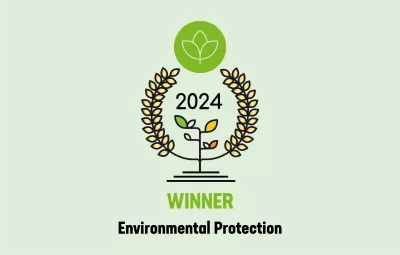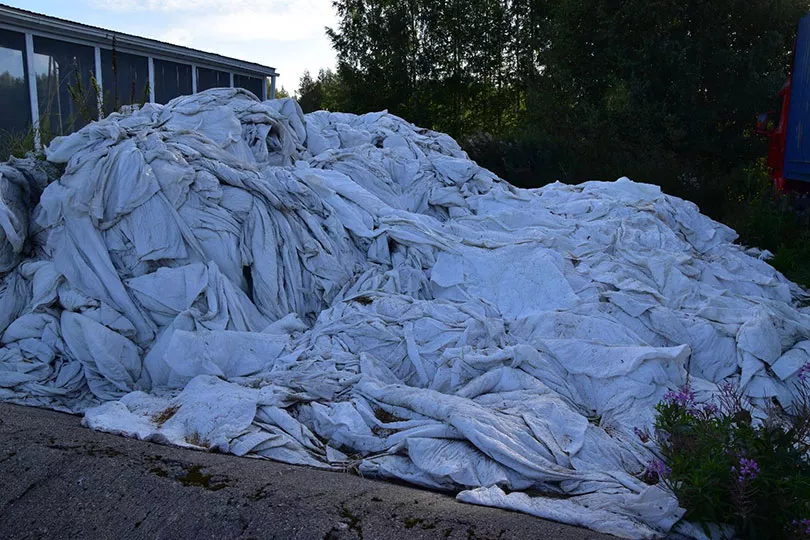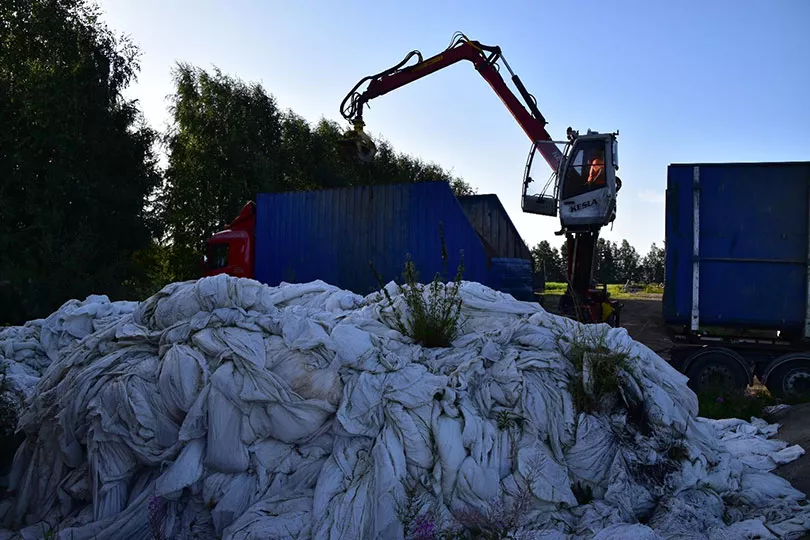General information
RDP Priority
- P6. Social inclusion and local development
RDP Focus Area
- 6A: Diversification & job creation
RDP Measure
- M16: Cooperation
Beneficiary type
- Operational group
Summary
The project aimed to develop sustainable solutions for storing, managing and reusing agricultural plastic waste, focusing on improving recycling across farms, logistics and material technology. The project was implemented in five regions in the Finnish Lakeland.
It was led by Jyväskylä University of Applied Sciences (Jamk), and its partners included the LAB University of Applied Sciences and the MTK North Savo regional farmers’ association. The project team combined professionals in agriculture, horticulture, logistics, materials engineering and chemistry with participation from several farms and businesses.
During the project, plastic waste types and locations were mapped on Finnish farms, profitable business opportunities were modelled fairly for all parties in the value chain, and preconditions for sorting, collecting and reusing plastic waste were developed.
The project facilitated collaboration among all stakeholders in the agricultural plastic waste chain, sharing information on previously unidentified waste management challenges. For example, researchers in the field were unaware that bale plastic collection was not done in an organised way.
The project developed operating models for logistics and a service for collecting plastic waste and prepared recycling guidelines for plastics. Information on plastic waste collection and recycling was disseminated through events and webinars.
Results
- Plastic waste investigated on 377 farms, information related to transport and utilisation collected from 15 companies in the waste chain (logistics, plastics processors, plastic waste users).
- Samples collected from eight farms to determine the quality of agricultural plastic waste in laboratory.
- 1 500+ million kilogrammes plastic waste (6%+ of plastic purchased by all farms each year nationally) collected from 173 farms.
- Five plastics transport/treatment companies participated in the collection of waste.
- Seven webinars, five recorded, 168 participants in those plus other events.
- Two podcasts, one video, five blog posts, five regional workshops.
- Three online editorials published in different media.
- Presence at Finnish Agricultural Science Days, Logistics Trade Fair, OKRA – The Real Farm Fair, regional circular economy fairs, open-door events and MTK (farmers’ association) events.

Promoter
Jamk University of Applied Sciences*
* The Project promoter/beneficiary is an EIP-AGRI Operational Group ©
Funding
Total budget: 276 271 (EUR)
EAFRD: 116 034 (EUR)
National/Regional: 133 592 (EUR)
Other non-EU funding sources: 26 646 (EUR)
Context
Finnish agricultural and horticultural farms produce approximately 12 million kilogrammes of plastic waste each year, with only 20% of it being recycled. Most of the plastic waste from farms is not packaging, but bale plastics, clamp plastics, plastic sheeting and gauze netting, as well as irrigation hoses.
Plastic plays an important role in Finnish agriculture by preserving feed for domestic animals during the long winter feeding season. It is valued for its hygienic, airtight, cost-effective and versatile properties in feed preservation.

Baling became widespread in the early 2000s, significantly increasing agricultural plastic waste. Previously, burying plastic waste was allowed, but now it is prohibited by law. However, the collection and treatment of agricultural plastic waste is not centrally organised, leading to regional variations in management practices.
The collection of agricultural plastic waste poses challenges due to Finland's sparse population and vast distances between regions. Also, not all areas have the necessary facilities for plastic waste management with recycling efforts concentrated primarily on the western coast of the country.
This project was funded through the environmental and climate programme of Lakeland Finland and implemented across Central Finland, North and South Savo, North Karelia, and Southeast Finland. North Savo, known for its significant milk production, ranks second among Finnish regions in agricultural plastic usage.
The regions of Lakeland Finland are part of the same catchment area, which is Europe's largest unified lake area. It contains thousands of bodies of water, making the area fragmented and logistics more difficult.
Objectives
The project set out to create and pilot new operating methods for sorting, packaging and storing plastic waste and handling dirty plastics. This would require modelling the material flow of agricultural plastics in the project area and mapping out existing storage terminals, to produce a cost-effective recycling model for agricultural plastics based on data.
Creating preconditions for new sustainable businesses and cooperation between farms was also a focus, in addition to communicating information on the recycling of plastic waste through events and digital materials to create awareness of both the problem and new solutions.
Activities
The project began with the team drawing up a communication plan, and then looking to identify and prioritise the measures that would be necessary. These started with mapping the amount and location of agricultural plastic waste generated in Finland and establishing which equipment would be required for the collection of agricultural plastic waste, as well as the parties and terminals that would receive that waste.
A plastics collection pilot programme was prepared and organised, which eventually enabled plastic samples to be collected from the pilot farms, with samples identified and analysed in a laboratory involving condition tests and pyrolysis. At this stage, analysis, visualisation and planning of operating models of the collected data were also carried out, which would later lead to the investigation of potential replacement materials for plastic.

A regional collection network for agricultural plastics was established in North Savo with two terminal companies and an incineration plant for plastic waste. Cooperation was also established with farmers' organisations, municipalities and waste companies in the respective operating areas, as well as plastic processors and research institutes.
Throughout the project, various communications operations were carried out on the implementation of the measures that had been decided on and the recycling of agricultural plastics in general. The project team also participated in regional and national events related to agriculture and logistics and involved stakeholders wherever possible.
Six information events to create awareness of the issues at stake and how the project would work were planned and then held. There were also five regional workshops. To share the results, the team wrote a publication and produced a video, and also presented the results at a seminar using various media.
Main results
Plastic waste was investigated on a total of 377 farms, and information related to its transport and utilisation was collected from 15 companies in the waste chain (e.g. logistics, plastics processors and plastic waste users).
The project collected more than 1 500 million kilogrammes of plastic waste from 173 farms. While this represents less than 0.5% of Finnish farms, the plastic waste collected was more than 6% of the amount of plastic purchased by all the farms each year nationally. In addition, five companies from the plastics transport and treatment sector participated in the collection of plastic waste. To determine the quality of agricultural plastic waste in the laboratory, samples were collected from eight of the farms.
The project was very active in disseminating the results of its activities. Seven webinars were held, of which five were recorded. Five regional workshops were organised, with 168 people participating in the webinars and other events of the project. Two podcasts and one video were recorded, while five blog posts and three online editorials on the project were published on various media.
The project has increased the understanding of farmers and actors in the agricultural plastic waste chain on the practices and collection bottlenecks of other actors in the chain, and on good practices in the circular economy. It has also provided information on the challenges of handling plastic waste on farms to other research and development organisations and administrative bodies through stakeholder cooperation.
Key lessons
The project collected more than 1.5 million kilogrammes of plastic waste from Lakeland Finland's farms, which is an incredible achievement in itself, beyond any secondary benefits that will come further down the line in terms of research and awareness. It involved many different actors and perspectives, but everyone had a shared intent and a genuine desire to develop the collection and recycling of agricultural plastics, and this was instrumental in the project’s success. Each stakeholder and their respective opinions were included from the start, with solutions sought by cross-pollinating different views and problems, and this helped to open up overarching operational solutions.
Aija Hytönen

